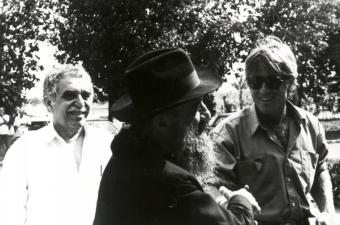 |
EL SIGLO DEL VIENTO
Das Jahrhundert des Sturms
Century
of the Wind
Fernando Birri
Uruguay / Deutschland 1999
Produktion: SURFilms.
Co-Produktion: Arte, TVE, Cine Ojo, CREA Audiovision, Cinemateca Uruguaya.
Weltvertrieb:
SURFilms, P.O.Box 102506, 28025 Bremen, Deutschland.
Tel.: (49-421) 5980 483, Fax: (49-421) 5980 485
Buch: Fernando Birri, Eduardo Galeano,nach dem gleichnamigen Buch von
Eduardo Galeano.
Regie: Fernando Birri.
Kamera: Libio Pensavalle, Udo Alberts.
Effekte: Hans Münch.
Musik/Ton: Gianni Nocenzi.
Mischung: Carsten Bucher.
Schnitt: Elke Schloo.
Produzenten: Yvonne Ruocco, Marcelo Cespedes, Detlef Ziegert. Design/Realisation:
Walter Tournier, Laura Severi.
Erzähler: Eduardo Galeano.
Format: Video, Farbe. Länge: 85 Minuten. Sprache: Spanisch.
|
Arsenal Do.11.02.1999 20.00
Arsenal Do.11.02.1999 24.00
Babylon Sa.13.02.1999 19.00
|
| ‘Erinnerung
an das Feuer’ heißt Eduardo Galeanos dreibändige Vision
von der 500jährigen Geschichte Lateinamerikas. Der letzte Band, der
sich mit dem 20. Jahrhundert beschäftigt, hat dem Werk von Fernando
Birri den Titel gegeben. Der fragmentarische Charakter der literarischen
Vorlage hat die filmische Umsetzung erleichtert. Galeano bietet keine
traditionelle Geschichtsschreibung, sondern ein aus vielfältigen
Quellen gespeistes Kaleidoskop von historischen Augenblicken und ihrer
Widerspiegelung in den verschiedensten, mitunter auch trivialen Bereichen
menschlicher Existenz. Fernando Birri, der ‘Stammvater’ alles
Neuen im lateinamerikanischen Kino, schätzt diese Collagetechnik,
die sich auch in seinem filmischen, literarischen und künstlerischen
Schaffen findet. Also fügt er den historischen Textfragmenten, von
der sonoren Erzählerstimme Galeanos gelesen, seine visuellen Bruchstücke
hinzu. Zwei eigenwillige Visionäre begegnen sich in einer bewegenden
Rückschau auf dieses Jahrhundert des Sturms. |
'Remembering the Fire' is
the title of Eduardo Galeano's three-volume vision of Latin America's
500-year history. The last volume deals with the 20th century. Fernando
Birri used its title for his film. The fragmentary character of the
literary work simplified filmic adaptation. Galeano did not produce
traditional history writing, instead he offers a kaleidoscope of historical
moments which come from a variety of sources. His work reflects the
most diverse, even trivial aspects of human existence. Fernando Birri,
the 'father' of all novelties in Latin American Cinema, loves this technique
of collage, which is also present in his filmic, literary and artistic
work. So he adds his own visual bric-a-brac to historical text fragments,
read by Galeano in a sonorous voice. Two unconventional visionaries
meet in this moving retrospective of this Century of the WIND. Walter
Tournier, the Uruguayan director of animation films, has created a kind
of red thread from an episode which reappears throughout Galeano's work,
that is, a puppet theatre. Using irony and biting wit, the story tells
us about the historical figure of Miguel Marmel, about his 'frequent
deaths' and 'numerous resurrections'. He can be considered the impersonation
of Latin America: always alive, even after frequent deaths, a survival
artist thanks to his unwavering will to resist the powerful.
|
Biofilmographie
/ Biofilmography
Fernando Birri wurde 1925 in Santa Fè/ Argentinien
geboren, wo er Sozialwissenschaften und Jura studierte, schon früh
Gedichte veröffentlichte, ein Studententheater leitete und als Schauspieler
auftrat. Von 1950 bis 1952 studierte er Filmregie am Centro Sperimentale
de Cinematografia in Rom. In dieser Zeit entstanden die ersten Kurzfilme.
1956 gründete er das 'Filminstitut der Universität des Litoral'
in Santa Fè, von dessen Dokumentarfilmproduktion ein entscheidender
Anstoß der Erneuerung des lateinamerikanischen Films ausging, zu der er
mit Tire diè (1960) wesentlich beitrug. Kurz darauf drehte er seinen
ersten Spielfilm Los Inundados (1961). Es folgten zahlreiche Reisen, die
ihn nach Kuba, China, Indien, Spanien, Algerien und in die Sowjetunion
führten, auf denen er seine Filmpraxis und -theorie vermittelte.
1964 machte er Rom zu seinem ständigen Wohnsitz. 1967 begann er seinen
großen Experimentalfilm ORG, an dem er über ein Jahrzehnt arbeitete.
Wieder folgte eine Zeit intensiver Reisen in alle Erdteile, zahlreicher
Retrospektiven seines Werks und vieler Ehrungen. Zum Höhepunkt seines
pädagogischen Wirkens wurde 1986 die Eröffnung der 'Internationalen
Film- und Fernsehschule' in San Antonio de los Baoos/Kuba, deren Konzeption
er wesentlich bestimmte und die er einige Jahre leitete. In den neunziger
Jahren beschäftigte er sich verstärkt mit der bildenden Kunst.
Seine Fotoglifos entstanden. Fernando Birri ist einer der wichtigsten
Anreger des lateinamerikanischen Films.
Fernando Birri was born in Santa Fè, Argentinia in
1925. He studied social sciences and law. He published poems early on,
managing a students' theatre and performing as an actor. Between 1950
and 1952 he studied direction at the Centro Sperimentale de Cinematografia
in Rome. In 1956 he founded the Film Institute of the University of Litoral
in Santa Fè. The documentary production of this institute helped
initiate the renewal of Latin American cinema in a major way. His film
Tire diè (1960) is an important contribution. Shortly afterwards,
he made his first feature-length film, Los Inundados (1961). He took many
journeys to Cuba, China, India, Spain, Algeria and the Soviet Union, where
he taught about his method of filmmaking and theory. In 1964 he moved
to Rome permanently. In 1967 he began to work on his great experimental
film ORG, on which he worked for over ten years. Then he began to travel
again extensively into all corners of the world. There were numerous retrospectives
of his work and he received many honours. In 1986 the International School
of Film and Television was founded in San Antonio de los Banos/Cuba, which
was the culmination point of his educational efforts. He had helped to
conceive it and was the director of this school for several years. In
the 90's he worked increasingly in the fine arts. His Fotoglifos are created.
Fernando Birri is one of the most important inspirations in Latin American
cinema.
Films / Filme
1951: U-bu, One i one. 1952: Selinunte, Alfabeto Notturno. 1953: Immagini
popolari siciliane profane. 1959: La verdadera historia de la primera
fundacion de Buenos Aires. 1960: Tire dié, Buenos días, Buenos Aires.
1961: Los inundados. 1963: La pampa gringa. 1967: Castagnino, diario romano.
1967-1978: ORG. 1983: Rafael Alberti, un retrato de poeta. 1984: Remitente:
Nicaragua (Carta al mundo). 1985: Mi hijo el Chè. 1988: Un senor
muy viejo con alas enormes, Diario de Macondo. 1997: Chè: Muerte
de la utopía? 1999: El siglo del viento. |


|